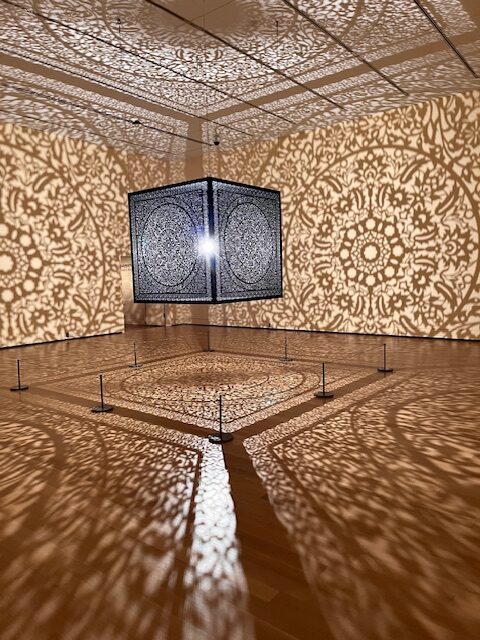Your cart is currently empty!
Peabody Essex Museum Refracts Light and Reflects on Historical Roots

Peabody Essex Museum captivates passersby on Essex Street in Salem, Massachusetts. A bright glass entrance welcomes visitors into the building. Sunlight seeps through the panes, playing around with shadows. The result ties together nature and science and art.
Through the glass doors loom expansive sandstone and brick walls. A glass roof refracts light across the tiled floor. Straight ahead of the ticketing desk lies the Nancy and George Putnam Gallery and Barbara Weld Putnam Gallery. These spaces display the ongoing exhibition On This Ground: Being and Belonging in America. Native American and American art collections combine to share the complicated story of what it means to live in America, a nation founded on colonization and oppression. The American experience includes Native American art, history, and culture. The collection includes In This Place by American poet Amanda Gorman, Wampanoag portraits in black and white, photographs, ceramics, textiles, abstract paintings, among others.
Down the corridor stands The Dotty Brown Art & Nature Center, currently showcasing the ongoing exhibition Narwhal: Revealing An Arctic Legend. The space dives into the deep value the narwhal brings to the Intuit community as a source of food, a sense of warmth, a vessel, and a commodity. The center includes narwhal lore depicted in fantastical paintings and educational soundbites from the mammal. In the middle of the room hangs a narwhal complete with its spiral tusk. One corner of the space welcomes visitors to use recycled materials to either make a narwhal or a part of the oceanic ecosystem. Guests can also engage in tactile activities through feeling pads to grasp the texture of a narwhal’s skin and its tusk.
The exit of The Dotty Brown Art & Nature Center leads to The Jeffrey P. Beale Gallery holding the ongoing installation Ballroom by Agustina Woodgate. The installation encourages guests to navigate through a field of geographic globes on the gallery floor. Woodgate sanded and smoothed the globes to remove nations and human-made boundaries. A video accompanies the installation in which Woodgate uses artificial intelligence to reconstruct images from an erased atlas.
Around the bend stands the ongoing exhibition Studio Glass. The selection of contemporary glass contains more than 40 of the most influential glass artists from the 20th century to today. The pieces were donated to the museum in 2022 by New York based collectors Carl and Betty Pforzheimer. The exhibition plays around with forms, expressions, and techniques.
The end of the corridor boasts a spiral wooden staircase. An alcove underneath the staircase holds a metallic abstract sculpture, providing a grounding force against the navy Rorschach-esque wall decor.
Up on the second floor, visitors find the Wheatland Family Gallery presenting the ongoing exhibition Anila Quayyum Agha: All the Flowers Are for Me. The gallery contains Persian and Turkish architecture, textiles, and miniature paintings. In the center of one room stands Intersections, a laser cut steel cube suspended from the ceiling and illuminated by one bulb. The piece casts beams and shadows across the floor, cultivating a welcoming space for all.
On the same floor are two galleries examining the South Asian experience in the ongoing exhibition South Asian Art. The Chester and Davida Herwitz Gallery focuses on nation-building and self-discovery following India’s independence from British rule in 1947. The Prashant H. Fadia Foundation and Deshpande Foundation Gallery features objects from the 19th century. The historic material grapples with India’s complicated history with foreign occupation and the lack of representation of Indian people in art.
The third floor holds the Carl and Iris Apfel Gallery and hosts the ongoing exhibition Fashion & Design. The gallery includes a collection of vibrant and flamboyant clothing that experiments with styling. The exhibition urges visitors to understand the motivations and capacity for designing ourselves and the world around us.
The Peabody Essex Museum showcases many more exhibitions and rotates their artwork on a regular cadence. For more information, visit https://pem.org/.